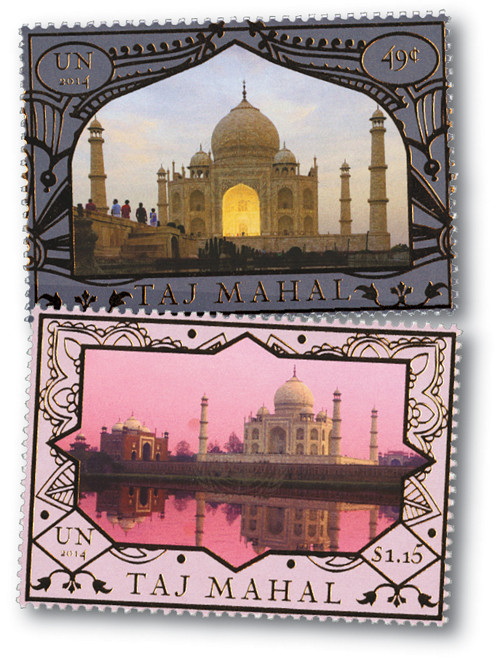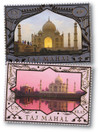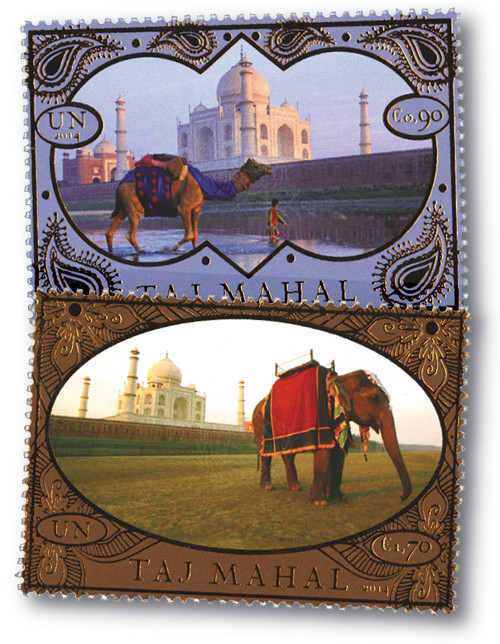
# UN1090-91 - 2014 49c & $1.15 World Heritage Sites, Taj Mahal
2014 U.N. World Heritage – India
New York Office
The 2014 World Heritage stamps feature the “jewel of Muslim art in India,” the Taj Mahal. The stamps, designed by Rorie Katz, each exhibit a different photograph of the 17th century funerary monument, illuminated by the varying light throughout the day and framed in stylized gold borders.
Mughal emperor Shah Jahan commissioned the Taj Mahal to memorialize his beloved wife, Persian princess Mumtaz Mahal, following her death in 1631. Stories say that Jahan’s grief inspired the endeavor and his lasting love saw it to completion. Both Jahan and Mahal are buried in its lower levels while their false tombs grace the central mausoleum under the white marble dome.
The magnificent complex is located along the right bank of the Yamuna River in the Agra District of Uttar Pradesh, India. Under the guidance of main architect Ustad Ahmad Lahauri, skilled stonecutters, masons, painters, calligraphers, and other artisans, along with thousands of laborers, built the unique structure and its outbuildings and gardens over a period of 21 years. Finally completed in 1653 AD, the Taj Mahal complex became, and remains, the greatest Indo-Islamic architectural achievement of all time.
The tomb is perfectly symmetrical from the top of the 70-foot-tall mausoleum dome to the four free-standing minarets framing the main structure. The main gate to the south of the tomb boasts the same symmetry, as do the gardens and the placement of the identical red sandstone mosque and guesthouse to either side of the tomb. Throughout the interior, the walls are adorned with Quaranic inscriptions and inlaid with precious and semiprecious stones in intricate designs. The white marble of the mausoleum takes on the hues of the sky, shining silver in the moonlight, glowing pink at dawn and burning a fiery red-orange at sunset.
The Taj Mahal is one of the New Seven Wonders of the World, attracting more than two million tourists from India and around the world each year. It is recognized as one of the universally admired masterpieces of the world’s heritage and was added to the UNESCO World Heritage list in 1983.
2014 U.N. World Heritage – India
New York Office
The 2014 World Heritage stamps feature the “jewel of Muslim art in India,” the Taj Mahal. The stamps, designed by Rorie Katz, each exhibit a different photograph of the 17th century funerary monument, illuminated by the varying light throughout the day and framed in stylized gold borders.
Mughal emperor Shah Jahan commissioned the Taj Mahal to memorialize his beloved wife, Persian princess Mumtaz Mahal, following her death in 1631. Stories say that Jahan’s grief inspired the endeavor and his lasting love saw it to completion. Both Jahan and Mahal are buried in its lower levels while their false tombs grace the central mausoleum under the white marble dome.
The magnificent complex is located along the right bank of the Yamuna River in the Agra District of Uttar Pradesh, India. Under the guidance of main architect Ustad Ahmad Lahauri, skilled stonecutters, masons, painters, calligraphers, and other artisans, along with thousands of laborers, built the unique structure and its outbuildings and gardens over a period of 21 years. Finally completed in 1653 AD, the Taj Mahal complex became, and remains, the greatest Indo-Islamic architectural achievement of all time.
The tomb is perfectly symmetrical from the top of the 70-foot-tall mausoleum dome to the four free-standing minarets framing the main structure. The main gate to the south of the tomb boasts the same symmetry, as do the gardens and the placement of the identical red sandstone mosque and guesthouse to either side of the tomb. Throughout the interior, the walls are adorned with Quaranic inscriptions and inlaid with precious and semiprecious stones in intricate designs. The white marble of the mausoleum takes on the hues of the sky, shining silver in the moonlight, glowing pink at dawn and burning a fiery red-orange at sunset.
The Taj Mahal is one of the New Seven Wonders of the World, attracting more than two million tourists from India and around the world each year. It is recognized as one of the universally admired masterpieces of the world’s heritage and was added to the UNESCO World Heritage list in 1983.








